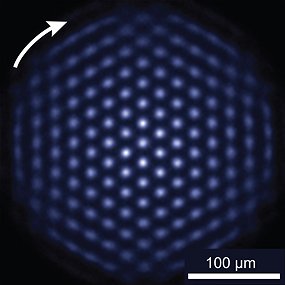Researchers Detail Quantum Computing ‘Breakthrough’

A team of scientists have today published the design details of an ion crystal, made up of just 300 atoms and a millimetre in diameter, capable of running a quantum computer so powerful that it would take a supercomputer the size of our known universe to match its performance.
Detailed by ABC Online and published in full in the journal Nature out today, the crystal simulator uses a property of quantum mechanics called ‘superposition’ to yield its power, “where a quantum particle appears to be in two distinct states at the same time.” The quantum bit – known as a ‘qubit’ – can then be used to solve two equations simultaneously. The bigger the number of qubits interacting, the greater the number of states, and consequentially the more and more calculations the computer can solve at any one time.
As the research’s co-author and the University of Sydney’s Dr Michael Biercuk explains, the team has “surpassed the computational potential of this system relative to classical computers by something like 10 to the [power of] 80, which is 80 orders of magnitude,” before concluding in no uncertain terms, “[it’s] a really enormous number.” He’s not wrong.
 “Quantum computing is a kind of information science that is based on the notion that if one performs computations in a fundamentally different way than the way your classical desktop computer works, there's a huge potential to solve a variety of problems that are very, very hard or near impossible for standard computers. It turns out that that [you’d need a] computer the size of the known universe [to match it],” Biercuk adds.
“Quantum computing is a kind of information science that is based on the notion that if one performs computations in a fundamentally different way than the way your classical desktop computer works, there's a huge potential to solve a variety of problems that are very, very hard or near impossible for standard computers. It turns out that that [you’d need a] computer the size of the known universe [to match it],” Biercuk adds.
Not that quantum computing doesn’t come without its own fair share of set-backs, the removal of which will determine whether or not we’ll be seeing such technologically-advanced computing in our own offices any time soon. “Everything depends on a huge amount of technical infrastructure around it,” informs Biercuk. “So there are vacuum chambers and pumps and lasers, and all that takes up something like a room.” Furthermore, “the quantum computer will move to a stage where it is so far out in front and performing such complex tasks it will be difficult to check if it is working accurately. They’re not easily checked by a classical computer which opens a whole variety of problems,” Biercuk concedes.
And yet at the same time, it’s important to look further back in the history of computing and remember that the very first traditional computers were also room-sized, crude in their processes and often made of raw materials such as wood.
Richard Birkett
Source: ABC Online

